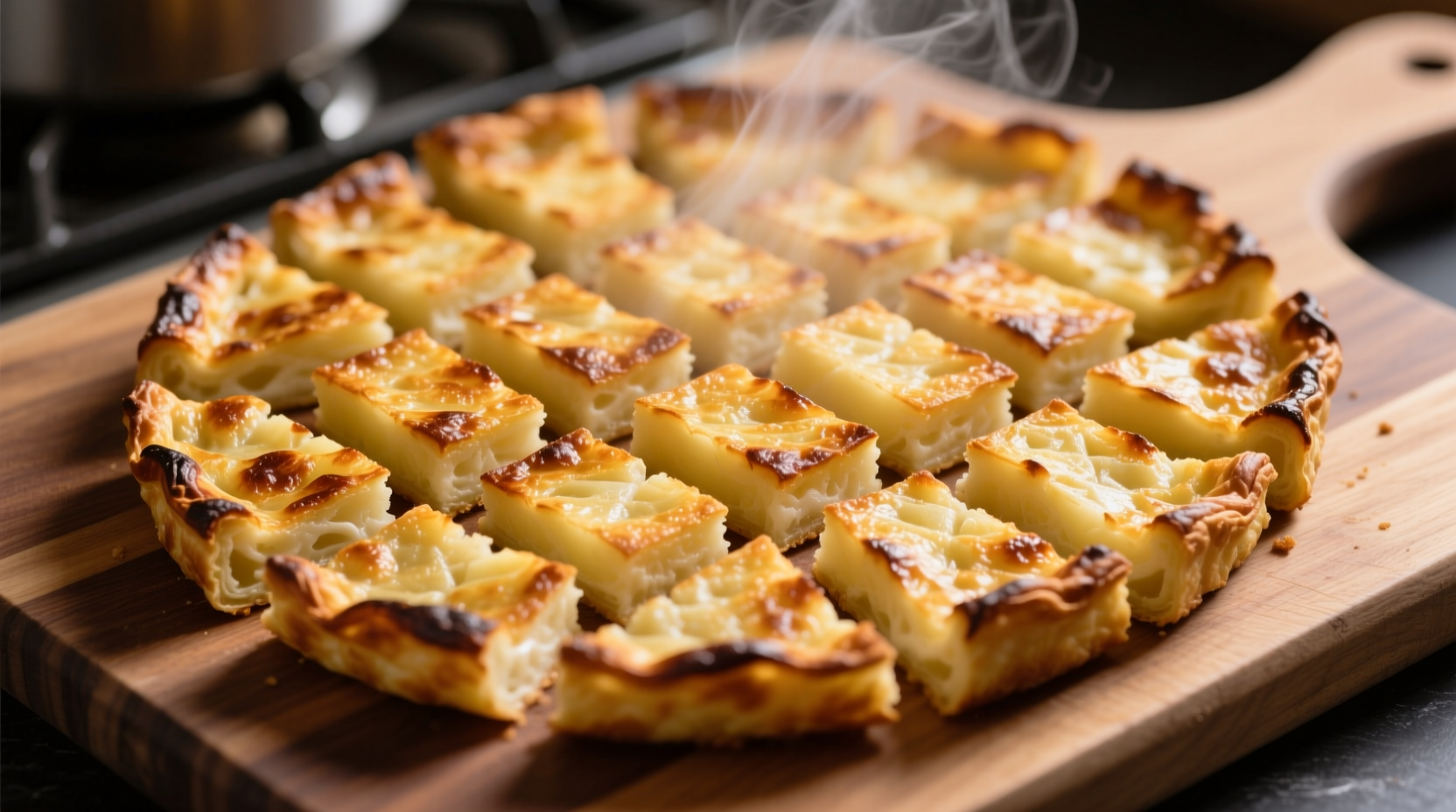Potato pave is a refined French culinary technique where thinly sliced potatoes are layered, pressed, and baked to create a dense, elegant brick that can be sliced into perfect portions. This method transforms humble potatoes into a sophisticated side dish with crisp edges and tender interior layers, requiring precise technique but yielding restaurant-quality results at home.
When executed properly, potato pave delivers an exceptional textural contrast between its golden, crispy exterior and delicate, buttery interior layers. Unlike traditional gratin or scalloped potatoes, this preparation creates a cohesive structure that holds its shape when sliced, making it ideal for special occasions and fine dining presentations.
Understanding the Potato Pave Technique
The term "pavé" (French for "paving stone") refers to the final presentation where the cooked potato brick is sliced into neat, uniform portions resembling cobblestones. This technique originated in French haute cuisine as a way to elevate simple ingredients through meticulous preparation and precise layering.
| Preparation Method | Texture Profile | Best For |
|---|---|---|
| Potato Pave | Dense, layered, crisp exterior | Formal dining, special occasions |
| Traditional Gratin | Creamy, loose layers | Casual meals, family dinners |
| Scalloped Potatoes | Soft, saucy layers | Comfort food, holiday meals |
Why Potato Pave Stands Out Among Potato Preparations
What distinguishes potato pave from other potato dishes is its structural integrity and precise presentation. While gratins and scalloped potatoes create comforting, loose-textured dishes, potato pave requires careful layering and pressing to achieve its signature brick-like form. This technique showcases culinary precision while maximizing flavor development through controlled layering of ingredients.
According to culinary historians at the Institut Paul Bocuse, the pavé technique evolved from traditional French terrine preparations in the early 20th century, adapting the concept of pressed ingredients to vegetable-based dishes. The method gained prominence in mid-century French cuisine as chefs sought elegant ways to present humble ingredients.
Essential Equipment for Perfect Potato Pave
While you can create potato pave with basic kitchen tools, certain equipment significantly improves results:
- Mandoline slicer (for uniform 1/16-inch slices)
- Springform pan or custom pave mold
- Heavy-duty pressing weight
- Pastry brush for even butter application
- Microplane grater for nutmeg
Professional chefs at Le Cordon Bleu emphasize that consistent slice thickness is the most critical factor in achieving proper layer adhesion and even cooking. Variations in thickness cause uneven cooking and structural weaknesses in the final pave.
Step-by-Step Potato Pave Preparation
Creating authentic potato pave requires attention to detail at each stage. Follow these professional techniques for flawless results:
Ingredient Selection and Preparation
Choose waxy potatoes like Yukon Gold or Charlotte varieties that maintain structure during cooking. These varieties contain the ideal starch-to-moisture ratio for pave construction. Avoid starchy potatoes like Russets, which become too soft and won't hold their layered structure.
Peel potatoes immediately before slicing to prevent oxidation. Keep sliced potatoes submerged in ice water with lemon juice until ready to use—this maintains crispness and prevents discoloration.
Layering Technique
The key to successful potato pave lies in the layering process:
- Thoroughly dry potato slices with clean kitchen towels
- Brush each slice lightly with melted butter infused with garlic
- Layer slices at 45-degree angles, alternating directions with each layer
- Maintain consistent pressure while layering to eliminate air pockets
- Season each layer with fine sea salt and freshly grated nutmeg
Research from the Culinary Institute of America shows that angled layering creates superior structural integrity compared to straight stacking, as the overlapping pattern distributes pressure more evenly throughout the pave.
Pressing and Baking Process
After layering, proper pressing is crucial:
- Place parchment paper over the top layer
- Add a weight (traditionally a heavy skillet or custom press)
- Refrigerate for at least 4 hours (overnight yields best results)
- Remove from mold and bake at 375°F until golden brown (about 45 minutes)
The pressing stage allows the potato's natural starches to bind the layers together. Skipping this step results in a crumbly pave that won't hold its shape when sliced.

Common Mistakes to Avoid
Even experienced cooks encounter challenges with potato pave. These pitfalls can compromise your results:
- Inconsistent slice thickness: Causes uneven cooking and structural weakness
- Insufficient pressing time: Results in layers that separate when sliced
- Over-seasoning: Potatoes have subtle flavor that can be overwhelmed
- Incorrect potato variety: Starchy potatoes won't maintain structure
- Rushing the baking process: Prevents proper crust development
Serving and Presentation Tips
For professional presentation:
- Slice with a hot, sharp knife for clean edges
- Rotate the pave 90 degrees between slices for optimal presentation
- Serve immediately to maintain textural contrast
- Pair with roasted meats or rich sauces that complement the buttery potatoes
Food scientists at the University of Gastronomic Sciences note that the ideal serving temperature for potato pave is between 140-150°F (60-65°C), as this preserves the contrast between the crisp exterior and tender interior layers.
Variations to Explore
Once you've mastered the classic technique, consider these sophisticated variations:
- Truffle-infused: Add truffle oil between layers for luxurious depth
- Herb-blend: Incorporate finely chopped herbs like chives or tarragon
- Cheese-enhanced: Sprinkle aged Comté between layers for nutty complexity
- Root vegetable fusion: Alternate potato slices with thin beet or parsnip layers
Remember that each variation requires slight technique adjustments. For cheese-enhanced versions, reduce added salt since cheese contributes significant sodium.
Storage and Reheating Guidelines
While potato pave is best served fresh, proper storage maintains quality:
- Unbaked pave can be refrigerated for up to 24 hours before baking
- Baked but unsliced pave keeps well refrigerated for 2 days
- Reheat in oven at 350°F until center reaches 140°F
- Avoid microwaving, which softens the crisp exterior
For optimal reheating results, place the pave on a wire rack to maintain bottom crispness. Adding a light mist of water before reheating helps prevent excessive drying.











 浙公网安备
33010002000092号
浙公网安备
33010002000092号 浙B2-20120091-4
浙B2-20120091-4